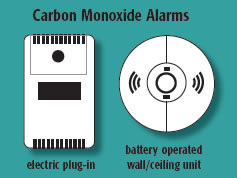|

Carbon monoxide is odorless, colorless and - in the case of an elderly Florida couple recently - deadly. A husband and wife were discovered dead in their Florida home recently. The cause of death is carbon monoxide poisoning.
Carbon monoxide is created when gas-fueled appliances, such as hot water heaters, furnaces and stoves, burn the gas fuel incompletely. There are fuel problems or system problems that can lead to the gas not burning completely and not venting the gas outside of the building. This is why it is so important to have carbon monoxide alarms inside every home. While there are many types of carbon monoxide alarms, many with additional features besides detecting the gas, the bottom line is that for about $25, you can save your life and the lives of those who live and stay at your home.
Gasoline-powered engines, barbecue grills and home fireplaces are other possible sources of carbon monoxide in the home. If you have a generator that you run during power outages, the carbon monoxide can leak into your home if you place it too close to your home.
Symptoms of carbon monoxide poisoning are very similar to flu symptoms, which can include headaches and nausea. If the whole family has the exact symptoms at the same time, you may need to consider carbon monoxide poisoning. Get everyone outside of the home and call your Livonia firefighters to investigate. Carbon monoxide can also lead to feelings of laziness and sleepiness, which can be a major problem if you are in an atmosphere with carbon monoxide. This is why it is important to get outside where you can think clearly.
In July, a Maryland family had a close call, after leaving their generator running inside an enclosed porch. The family got out of the home and drove to the fire station to report their sickness, which peaked when the home's carbon monoxide alarms started sounding. Luckily, they took action and got out alive.
Read the instructions that come with your carbon monoxide alarm, as some are designed for installation on the ceiling or high on the wall, similar to your smoke alarms. Other carbon monoxide alarms are units that plug into an electrical outlet and run off the electricity in the home. They should also be tested monthly so you can check them when you are checking your smoke alarms. If your alarm runs off electricity, it may have a battery backup to keep it active in case of power outages. If your carbon monoxide alarm runs on a battery, it needs to be replaced annually. Again, you can replace it when you replace your smoke alarm batteries.
If you are not sure why your alarm might be going off, or if you suspect carbon monoxide or smoke may be in your home, call your Livonia firefighters out to check it out.
Tom Kiurski is training coordinator for the Livonia Fire Department.
|
